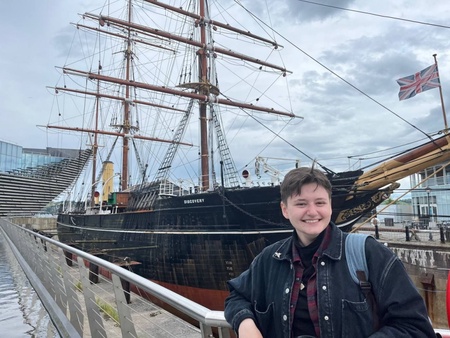Our QUADRAT research experience intern Mariia Topol conducts project on monitoring, mapping and modelling coastal erosion at Royal Aberdeen Golf Course
The Aberdeen Institute for Coastal Science and Management (AICSM) was recently awarded a NERC Quadrat Research Experience Placements Internship for a period of ten weeks in the Summer of 2024.
Mariia Topol, who is originally from the Ukraine, was the successful applicant. She is currently a second-year student studying Physics and Mathematics at the University of Aberdeen and supervised by David R. Green and Dmitri Mauquoy in the Department of Geography at the University of Aberdeen. One of the conditions of the award is that the student must be from a different discipline to Geography – although some relevant background in environmental studies and quantitative science is deemed to be of benefit. Indeed, Mariia’s background brings a wealth of mathematical skills and also some useful drone experience to the project.
To date, Mariia has been very busy working on this coastal project entitled: Monitoring, Mapping and Modelling Coastal Erosion of Golf Courses: Ground Control for Drone Image Acquisition. The purpose of this project is to further develop and enhance the existing and ongoing coastal monitoring project for a golf course in Aberdeen. Whilst the monitoring and mapping of several coastal golf courses in England, Scotland and Northern Ireland has been active for the past 5 years with the help of three AICSM drone pilots, the current focus of the project is on the Royal Aberdeen Golf Course which is currently developing a long-term plan for their golf course in light of the impacts of climate change.
Overall the project will: (a) involve the student developing an overview and understanding of coastal erosion, drone data collection, softcopy photogrammetric data processing, and the derivation of spatial information for analysis and input to a Geographic Information System (GIS; (b) the practical use of an RTK GPS system to survey in Ground Control Points (GCPs) at the study site to improve accuracy of measurements; (c) the input of the data into a GIS database for geo-visualisation, spatial analysis, and visual communication including the use of ESRI Storymap and webGIS software and; (d) the design and creation of a scientific poster to aid in raising awareness and education about the impacts of coastal erosion.
Aside from studying the UAV monitoring work that has already been carried out to date, researching the scientific literature, arranging meetings with a local coastal Engineer – Ray Lawrenson (Siskin Asset Management), who just happens to be a keen golfer, Mariia is now working with the drone pilots to look into the positioning and layout of a network of new ground control points (GCPs) for the study site as a basis for more detailed drone surveys in the future. At the end of the internship, Mariia will present some of the work she has been doing in the form of a report, poster, and storymap.


